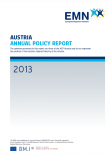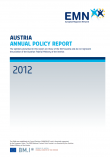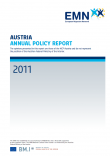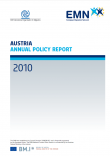The aim of the Annual Policy Reports is to outline the most significant political and legislative developments in the EU Member States and at European level as well as to inform about public debates in the area of migration and asylum within the EU Member States.
Serving as the basis of the Annual Policy Reports, the Annual Reports on Asylum and Migration Statistics present for the specific Member State an analysis of the statistical trends in asylum and migration during the reference year. The Annual Reports on Asylum and Migration Statistics were prepared by the European Migration Network (EMN) up to and including 2009.
With the help of an external service provider, the European Commission publishes an EU Synthesis Report summarizing the main findings from the National Reports prepared by the National Contact Points.
Annual Policy Report 2013
The Annual Policy Report 2013 provides an overview of migration and asylum-related debates and developments in Austria. In 2013, an important development was the movement of integration agendas from the Ministry of the Interior to the Federal Ministry for Europe, Integration and Foreign Affairs. The Amendments to the Citizenship Law that introduced inter alia a facilitated citizenship for very well integrated migrants represented one of the main legislative changes. Asylum-related topics such as reception conditions, the admission of Syrian refugees and the death of migrants off the Italian coast were the topics covered most comprehensively by the Austrian press.
Annual Policy Report 2012
The Annual Policy Report 2012 provides an overview of migration and asylum-related developments in Austria. In 2012, a major administrative change was decided: the establishment of the Federal Office for Immigration and Asylum on 1 January 2014. Moreover, the implementation of the Red-White-Red Card for highly qualified immigrants was completed as well. Besides these and other developments, the topic of reception conditions for asylum seekers was covered in the media often.
Annual Policy Report 2011
The Annual Policy Report 2011 provides an overview of migration and asylum-related debates and developments in Austria. The main policy and legislative developments in Austria in 2011 concerned the immigration of (highly) qualified workers, integration issues and the introduction of free legal aid. These developments were accompanied by extensive debates in the media and among relevant actors in the field of migration and asylum.
- Annual Policy Report Austria (EN)
- EMN Inform: EU Developments in International Protection
- EMN Inform: Developments in Legal Migration and Mobility (EN)
- EMN Inform: Maximising the Development Impact of Migration and Mobility (EN)
- EMN Inform: Responding to Migratory Pressures (EN)
- EC Report on Immigration and Asylum (EN)
- EC SWD accompanying the Report on Immigration and Asylum (EN)
- Other Country Reports
Annual Policy Report 2010
The Annual Policy Report 2010 provides an overview of migration- and asylum related debates and developments in Austria, i.e. concerning the development of the Red-White-Red Card, debates on the suggested amendments of the Aliens' Law 2011 or institutional developments.
Annual Policy Report 2009
The Annual Policy Report 2009 provides an overview of migration and asylum-related developments and debates in Austria. The report concentrates on the two amendments of the Aliens’ Law which were adopted in 2009 and entered into force on 1 January 2010. One deals primarily with the revision of different humanitarian residence permits. The other amendment introduced significant changes to the immigration and asylum system in Austria, including subsequent asylum applications, the treatment of delinquent persons granted asylum and beneficiaries of subsidiary protection, as well as age assessment.
Annual Report on Migration and International Protection Statistics 2009
The National Report describes the statistical trends in migration, international protection, refusals, apprehensions, residence permits, and return for the year 2009 in Austria. The report stresses that the Austrian net-migration gain was about 40 per cent smaller than in the previous year, which mainly resulted from a significant increase of outflows. Furthermore, in line with global trends, an increase in asylum applications by 24 per cent was registered in Austria in 2009. After a sharp decrease of the number of irregular migrants apprehended in 2007 mainly caused by the exclusion of citizens of Romania and Bulgaria as a result of their EU accession, the number continued to increase (i.e. by 18% between 2008 and 2009). Also the number of persons that were ordered to leave Austria increased in 2009, i.e. by +20 per cent compared to 2008.
Annual Policy Report 2008
This Policy Report gives an overview of the key political debates and developments in the field of migration and asylum in Austria in 2008. One of the main policy and legislative developments was the debate on the criteria for granting humanitarian residence which led to a request by the Constitutional Court to specify the criteria in the Settlement and Residence Law. Another important development was the establishment of a National Action Plan on Trafficking in Human Beings. The most important institutional development constituted the establishment of the Asylum Court which – as of 1 July 2008 – replaced the Independent Federal Asylum Senate as the second instance asylum authority.
Annual Report on Migration and International Protection Statistics 2008
The National Report provides an overview of statistical trends in migration, international protection, irregular entry and stay, residence permits, and return for the year 2008 in Austria. One of the main developments was the increase of immigration to Austria by 3 per cent compared to 2007. This upswing has to be seen in the light of the accession of Bulgaria and Romania to the European Union in 2007. With regard to international protection a continued decline in asylum applications could be observed in Austria since 2002. This trend was discontinued in 2008 when the number increased by 6 per cent compared to 2007.
Annual Policy Report 2007
This report gives an overview of the developments in the Austrian immigration, asylum and integration policy, legislation and debates in 2007. Among the important institutional developments are the establishment of an Integration Platform and the decision to establish an Asylum Court. Furthermore, a number of new laws were adopted. Among the most significant laws are the Prison Relief Package and the new laws concerning the asylum procedure, which were adopted in the context of the establishment of the Asylum Court. Policy debates deal mainly with the call for a reform of the migration system in order to open the labour market for highly skilled workers and to facilitate the application procedure.
Annual Report on Asylum and Migration Statistics 2007
The National Report analyses the trends and changes in Austrian asylum and migration statistics for the year 2007. A main long-term trend highlighted in the report is the decline in the number of asylum applications in Austria since 2002, a consequence of the coming into effect of the Dublin Convention in 2003. This trend continued in 2007 when the number of asylum applications declined by two thirds compared to 2002. In contrast to the area of asylum, immigration to Austria gained momentum in 2007, mainly as a result of the second wave of the EU Eastern enlargement.





